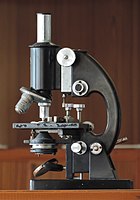
Photo from wikipedia
Abstract At the European Spallation Source (ESS), a Target Imaging System (TIS) has been proposed to monitor the integrity of the target wheel. The TIS signal will be provided by… Click to show full abstract
Abstract At the European Spallation Source (ESS), a Target Imaging System (TIS) has been proposed to monitor the integrity of the target wheel. The TIS signal will be provided by the gamma decay photons from the activated tungsten bricks of the target. To collect the photons, a linear array of 500 scintillators is mounted on a collimator and the imaging is achieved via a push-broom method. Scintillation light will be carried by optical fibers to an intensified sCMOS camera. This study presents a characterization of the performance of the full detector chain: emission from crystals, attenuation in optical fibers and response of the camera optics. The behaviour of both unirradiated and irradiated optical fibers is also evaluated for γ-only irradiations up to 15 kGy . Among the tested crystals (LuAG:Ce, YAG:Ce and BGO), LuAG:Ce is the preferred choice both in terms of radiation hardness and photon yield. Losses induced by Poly methyl methacrylate (PMMA) and quartz optical fibers are ~ 65 % and ~ 45 % , respectively. In ESS conditions, over half-year of continuous operations, PMMA fibers are estimated to lose an additional 3 % , compared to 2% for quartz fibers. Both PMMA and quartz fibers represent a potentially viable choice: the former suffer a more serious radiation damage than the latter, but formation of permanent defects in quartz can impair the efficiency of quartz fibers in the 580 − 620 nm range. Mix-and-match of PMMA and quartz fibers may represent a cost-effective compromise for the final TIS design. Two different fibers-camera coupling optics are compared. The measured difference in transmittance is 3 % .
Journal Title: Radiation Measurements
Year Published: 2020
Link to full text (if available)
Share on Social Media: Sign Up to like & get
recommendations!